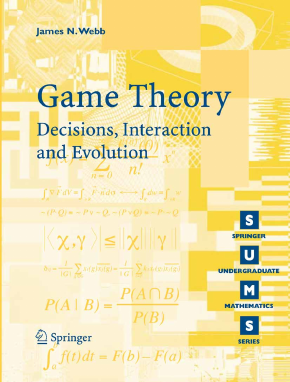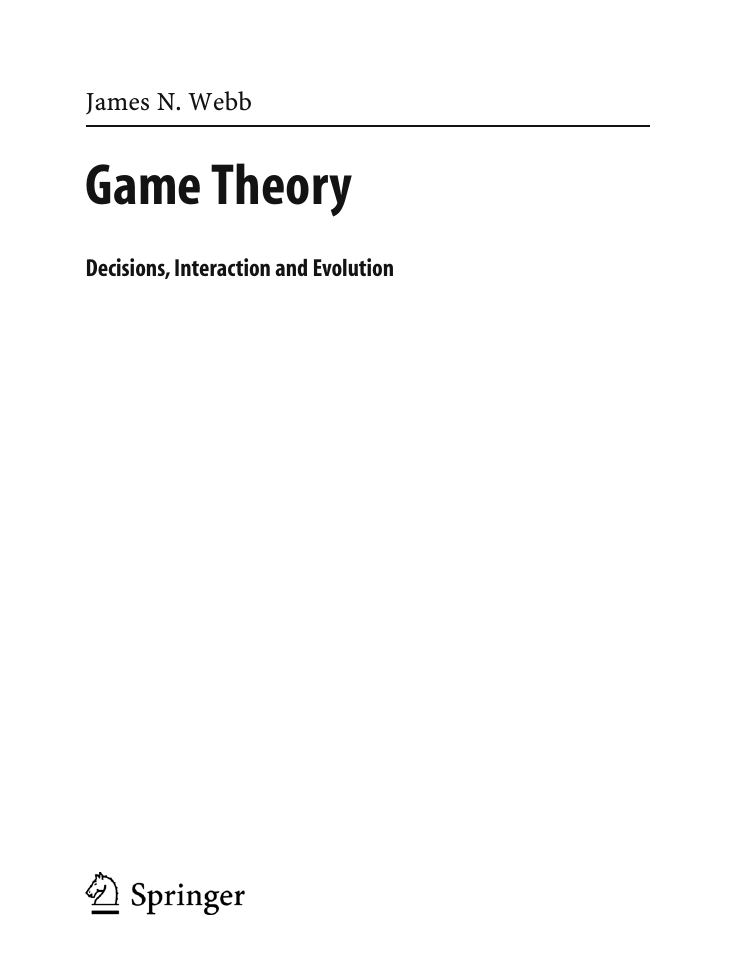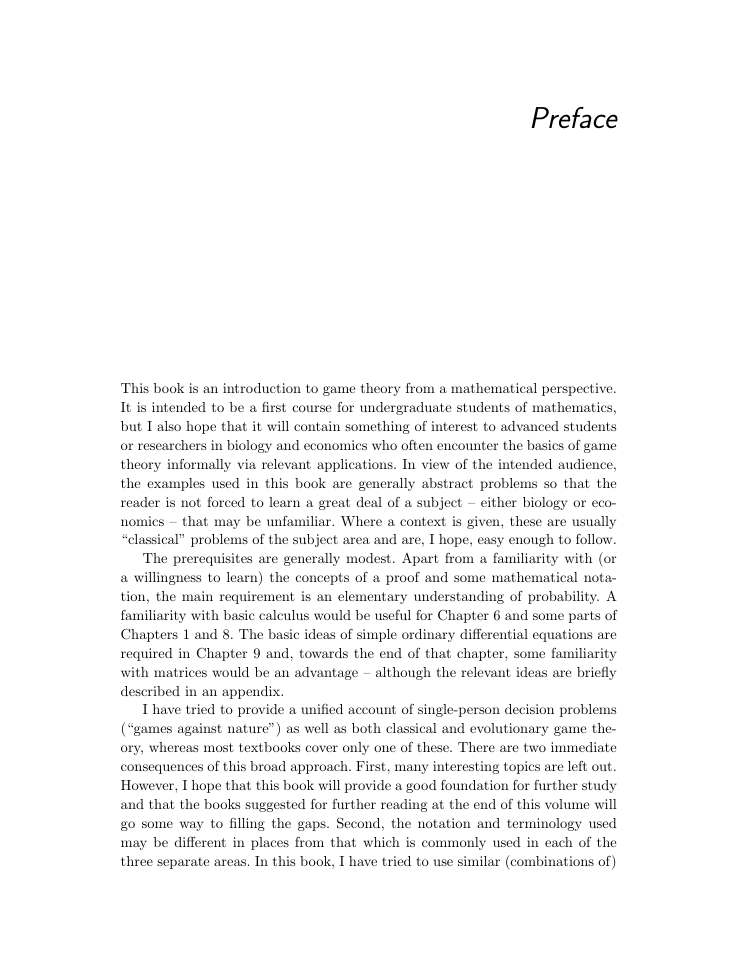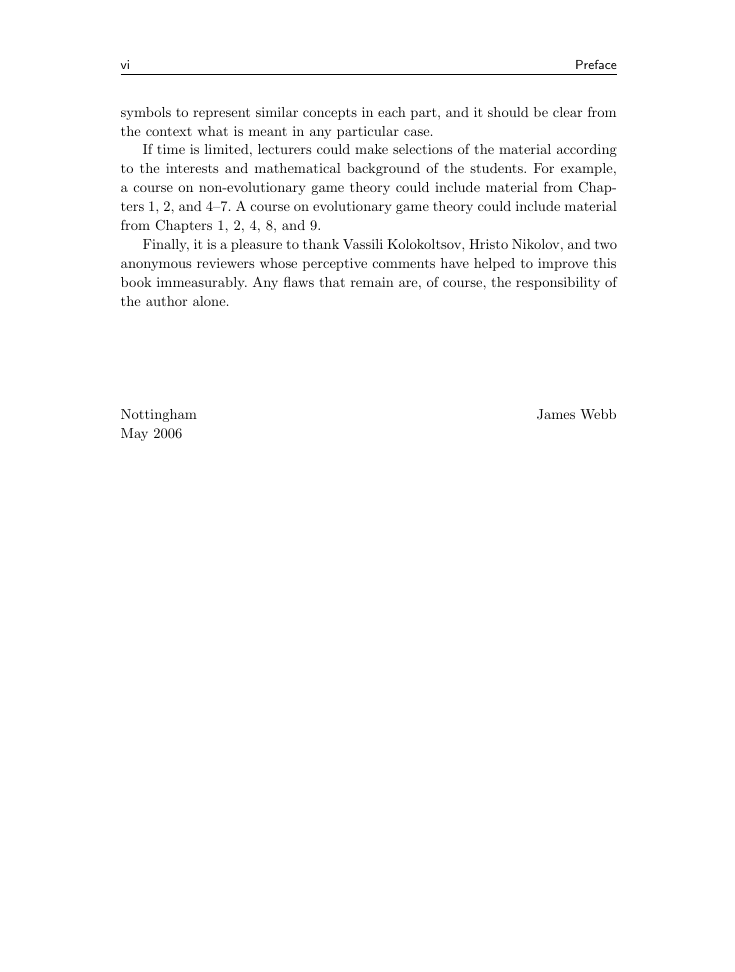�
Springer Undergraduate Mathematics Series
Advisory Board
M.A.J. Chaplain University of Dundee
K. Erdmann Oxford University
A. MacIntyre Queen Mary, University of London
L.C.G. Rogers University of Cambridge
E. Süli Oxford University
J.F. Toland University of Bath
Other books in this series
A First Course in Discrete Mathematics I. Anderson
Analytic Methods for Partial Differential Equations G. Evans, J. Blackledge, P. Yardley
Applied Geometry for Computer Graphics and CAD, Second Edition D. Marsh
Basic Linear Algebra, Second Edition T.S. Blyth and E.F. Robertson
Basic Stochastic Processes Z. Brze´zniak and T. Zastawniak
Calculus of One Variable K.E. Hirst
Complex Analysis J.M. Howie
Elementary Differential Geometry A. Pressley
Elementary Number Theory G.A. Jones and J.M. Jones
Elements of Abstract Analysis M. Ó Searcóid
Elements of Logic via Numbers and Sets D.L. Johnson
Essential Mathematical Biology N.F. Britton
Essential Topology M.D. Crossley
Fields and Galois Theory J.M. Howie
Fields, Flows and Waves: An Introduction to Continuum Models D.F. Parker
Further Linear Algebra T.S. Blyth and E.F. Robertson
General Relativity N.M.J. Woodhouse
Geometry R. Fenn
Groups, Rings and Fields D.A.R. Wallace
Hyperbolic Geometry, Second Edition J.W. Anderson
Information and Coding Theory G.A. Jones and J.M. Jones
Introduction to Laplace Transforms and Fourier Series P.P.G. Dyke
Introduction to Lie Algebras K. Erdmann and M.J. Wildon
Introduction to Ring Theory P.M. Cohn
Introductory Mathematics: Algebra and Analysis G. Smith
Linear Functional Analysis B.P. Rynne and M.A. Youngson
Mathematics for Finance: An Introduction to Financial Engineering M. Capi´nski and T. Zastawniak
Matrix Groups: An Introduction to Lie Group Theory A. Baker
Measure, Integral and Probability, Second Edition M. Capi´nski and E. Kopp
Metric Spaces M. Ó Searcóid
Multivariate Calculus and Geometry, Second Edition S. Dineen
Numerical Methods for Partial Differential Equations G. Evans, J. Blackledge, P.Yardley
Probability Models J. Haigh
Real Analysis J.M. Howie
Sets, Logic and Categories P. Cameron
Special Relativity N.M.J. Woodhouse
Symmetries D.L. Johnson
Topics in Group Theory G. Smith and O. Tabachnikova
Vector Calculus P.C. Matthews
�
James N. Webb
Game Theory
Decisions, Interaction and Evolution
�
James N. Webb, BSc, PhD, CPhys, MInstP
Cover illustration elements reproduced by kind permission of:
Aptech Systems, Inc., Publishers of the GAUSS Mathematical and Statistical System, 23804 S.E. Kent-Kangley Road, Maple Valley, WA 98038, USA. Tel: (206)
432 - 7855 Fax (206) 432 - 7832 email: info@aptech.com URL: www.aptech.com.
American Statistical Association: Chance Vol 8 No 1, 1995 article by KS and KW Heiner ‘Tree Rings of the Northern Shawangunks’ page 32 fig 2.
Springer-Verlag: Mathematica in Education and Research Vol 4 Issue 3 1995 article by Roman E Maeder, Beatrice Amrhein and Oliver Gloor ‘Illustrated
Mathematics: Visualization of Mathematical Objects’ page 9 fig 11, originally published as a CD ROM ‘Illustrated Mathematics’ by TELOS: ISBN 0-387-
14222-3, German edition by Birkhauser: ISBN 3-7643-5100-4.
Mathematica in Education and Research Vol 4 Issue 3 1995 article by Richard J Gaylord and Kazume Nishidate ‘Traffic Engineering with Cellular Automata’
page 35 fig 2. Mathematica in Education and Research Vol 5 Issue 2 1996 article by Michael Trott ‘The Implicitization of a Trefoil Knot’ page 14.
Mathematica in Education and Research Vol 5 Issue 2 1996 article by Lee de Cola ‘Coins, Trees, Bars and Bells: Simulation of the Binomial Process’ page 19
fig 3. Mathematica in Education and Research Vol 5 Issue 2 1996 article by Richard Gaylord and Kazume Nishidate ‘Contagious Spreading’ page 33 fig 1.
Mathematica in Education and Research Vol 5 Issue 2 1996 article by Joe Buhler and Stan Wagon ‘Secrets of the Madelung Constant’ page 50 fig 1.
Mathematics Subject Classification (2000): 90C39; 90C40; 91A05; 91A06; 91A10; 91A13; 91A15; 91A18; 91A20; 91A22;
91A25; 91A30; 91A35; 91A40
British Library Cataloguing in Publication Data
A catalogue record for this book is available from the British Library
Library of Congress Control Number: 2006931002
Springer Undergraduate Mathematics Series ISSN 1615-2085
e-ISBN-10: 1-84628-636-0
ISBN-10: 1-84628-423-6
ISBN-13: 978-1-84628-423-6
e-ISBN-13: 978-1-84628-636-0
Printed on acid-free paper
© Springer-Verlag London Limited 2007
The right of James N. Webb to be identified as the author of this work has been asserted in accordance with Sections
77 and 78 of the Copyright Designs and Patents Act 1988.
Apart from any fair dealing for the purposes of research or private study, or criticism or review, as permitted under
the Copyright, Designs and Patents Act 1988, this publication may only be reproduced, stored or transmitted, in any
form or by any means, with the prior permission in writing of the publishers, or in the case of reprographic
reproduction in accordance with the terms of licences issued by the Copyright Licensing Agency. Enquiries concerning
reproduction outside those terms should be sent to the publishers.
The use of registered names, trademarks, etc. in this publication does not imply, even in the absence of a specific
statement, that such names are exempt from the relevant laws and regulations and therefore free for general use.
The publisher makes no representation, express or implied, with regard to the accuracy of the information contained
in this book and cannot accept any legal responsibility or liability for any errors or omissions that may be made.
9 8 7 6 5 4 3 2 1
Springer Science+Business Media
springer.com
�
Preface
This book is an introduction to game theory from a mathematical perspective.
It is intended to be a first course for undergraduate students of mathematics,
but I also hope that it will contain something of interest to advanced students
or researchers in biology and economics who often encounter the basics of game
theory informally via relevant applications. In view of the intended audience,
the examples used in this book are generally abstract problems so that the
reader is not forced to learn a great deal of a subject – either biology or eco-
nomics – that may be unfamiliar. Where a context is given, these are usually
“classical” problems of the subject area and are, I hope, easy enough to follow.
The prerequisites are generally modest. Apart from a familiarity with (or
a willingness to learn) the concepts of a proof and some mathematical nota-
tion, the main requirement is an elementary understanding of probability. A
familiarity with basic calculus would be useful for Chapter 6 and some parts of
Chapters 1 and 8. The basic ideas of simple ordinary differential equations are
required in Chapter 9 and, towards the end of that chapter, some familiarity
with matrices would be an advantage – although the relevant ideas are briefly
described in an appendix.
I have tried to provide a unified account of single-person decision problems
(“games against nature”) as well as both classical and evolutionary game the-
ory, whereas most textbooks cover only one of these. There are two immediate
consequences of this broad approach. First, many interesting topics are left out.
However, I hope that this book will provide a good foundation for further study
and that the books suggested for further reading at the end of this volume will
go some way to filling the gaps. Second, the notation and terminology used
may be different in places from that which is commonly used in each of the
three separate areas. In this book, I have tried to use similar (combinations of)
�
vi
Preface
symbols to represent similar concepts in each part, and it should be clear from
the context what is meant in any particular case.
If time is limited, lecturers could make selections of the material according
to the interests and mathematical background of the students. For example,
a course on non-evolutionary game theory could include material from Chap-
ters 1, 2, and 4–7. A course on evolutionary game theory could include material
from Chapters 1, 2, 4, 8, and 9.
Finally, it is a pleasure to thank Vassili Kolokoltsov, Hristo Nikolov, and two
anonymous reviewers whose perceptive comments have helped to improve this
book immeasurably. Any flaws that remain are, of course, the responsibility of
the author alone.
Nottingham
May 2006
James Webb
�
Contents
Part I. Decisions
3
1. Simple Decision Models . . . . . . . . . . . . . . . . . . . . . . . . . . . . . . . . . . . .
3
1.1 Optimisation . . . . . . . . . . . . . . . . . . . . . . . . . . . . . . . . . . . . . . . . . . . . .
1.2 Making Decisions . . . . . . . . . . . . . . . . . . . . . . . . . . . . . . . . . . . . . . . . .
5
1.3 Modelling Rational Behaviour . . . . . . . . . . . . . . . . . . . . . . . . . . . . . . 11
1.4 Modelling Natural Selection . . . . . . . . . . . . . . . . . . . . . . . . . . . . . . . 17
1.5 Optimal Behaviour . . . . . . . . . . . . . . . . . . . . . . . . . . . . . . . . . . . . . . . 21
2. Simple Decision Processes . . . . . . . . . . . . . . . . . . . . . . . . . . . . . . . . . . 23
2.1 Decision Trees . . . . . . . . . . . . . . . . . . . . . . . . . . . . . . . . . . . . . . . . . . . 23
2.2 Strategic Behaviour . . . . . . . . . . . . . . . . . . . . . . . . . . . . . . . . . . . . . . . 24
2.3 Randomising Strategies . . . . . . . . . . . . . . . . . . . . . . . . . . . . . . . . . . . 27
2.4 Optimal Strategies . . . . . . . . . . . . . . . . . . . . . . . . . . . . . . . . . . . . . . . . 31
3. Markov Decision Processes . . . . . . . . . . . . . . . . . . . . . . . . . . . . . . . . . 37
3.1 State-dependent Decision Processes . . . . . . . . . . . . . . . . . . . . . . . . . 37
3.2 Markov Decision Processes . . . . . . . . . . . . . . . . . . . . . . . . . . . . . . . . 39
3.3 Stochastic Markov Decision Processes . . . . . . . . . . . . . . . . . . . . . . . 42
3.4 Optimal Strategies for Finite Processes . . . . . . . . . . . . . . . . . . . . . . 46
3.5 Infinite-horizon Markov Decision Processes . . . . . . . . . . . . . . . . . . 48
3.6 Optimal Strategies for Infinite Processes . . . . . . . . . . . . . . . . . . . . . 50
3.7 Policy Improvement . . . . . . . . . . . . . . . . . . . . . . . . . . . . . . . . . . . . . . 54
Part II. Interaction
�
















 2023年江西萍乡中考道德与法治真题及答案.doc
2023年江西萍乡中考道德与法治真题及答案.doc 2012年重庆南川中考生物真题及答案.doc
2012年重庆南川中考生物真题及答案.doc 2013年江西师范大学地理学综合及文艺理论基础考研真题.doc
2013年江西师范大学地理学综合及文艺理论基础考研真题.doc 2020年四川甘孜小升初语文真题及答案I卷.doc
2020年四川甘孜小升初语文真题及答案I卷.doc 2020年注册岩土工程师专业基础考试真题及答案.doc
2020年注册岩土工程师专业基础考试真题及答案.doc 2023-2024学年福建省厦门市九年级上学期数学月考试题及答案.doc
2023-2024学年福建省厦门市九年级上学期数学月考试题及答案.doc 2021-2022学年辽宁省沈阳市大东区九年级上学期语文期末试题及答案.doc
2021-2022学年辽宁省沈阳市大东区九年级上学期语文期末试题及答案.doc 2022-2023学年北京东城区初三第一学期物理期末试卷及答案.doc
2022-2023学年北京东城区初三第一学期物理期末试卷及答案.doc 2018上半年江西教师资格初中地理学科知识与教学能力真题及答案.doc
2018上半年江西教师资格初中地理学科知识与教学能力真题及答案.doc 2012年河北国家公务员申论考试真题及答案-省级.doc
2012年河北国家公务员申论考试真题及答案-省级.doc 2020-2021学年江苏省扬州市江都区邵樊片九年级上学期数学第一次质量检测试题及答案.doc
2020-2021学年江苏省扬州市江都区邵樊片九年级上学期数学第一次质量检测试题及答案.doc 2022下半年黑龙江教师资格证中学综合素质真题及答案.doc
2022下半年黑龙江教师资格证中学综合素质真题及答案.doc